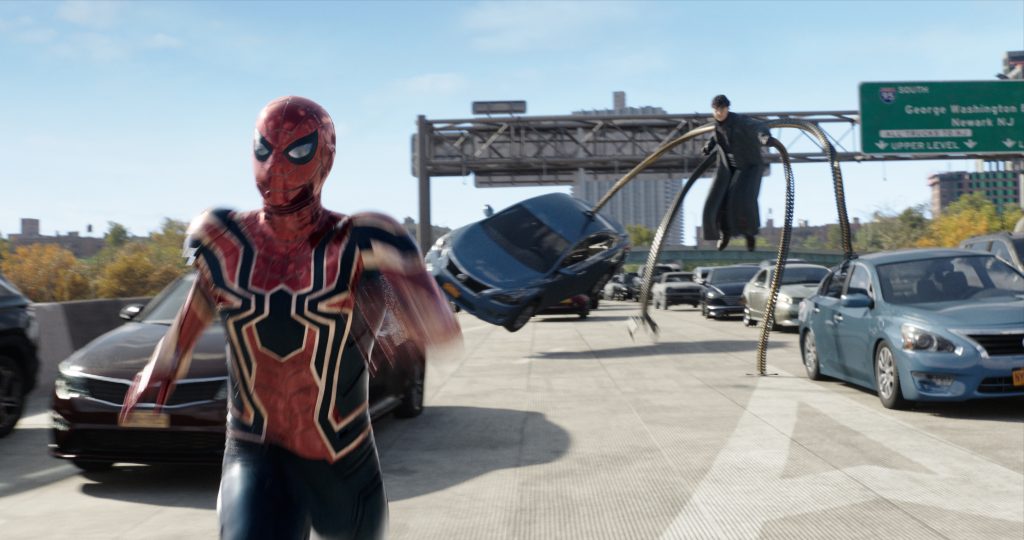April 30, 2023
by Carla Hay

Directed by Alex Lehmann
Culture Representation: Taking place in Azalea, Oregon, the dramatic film “Acidman” features a predominantly white cast of character (with one African American) representing the working-class and middle-class.
Culture Clash: A married woman in her 30s goes to a remote area to reconnect with her estranged father, who is living in isolation and obsessed with looking for UFOs and outer-space beings that he thinks are visiting Earth.
Culture Audience: “Acidman” will appeal primarily to people who fans of the movie’s headliners and who are interested in watching a boring film about boring people.

“Acidman” might have been better as a short film. Except for a few emotionally charged moments, this tepid drama about an adult daughter reconnecting with her estranged reclusive father is dragged down by dull and listless scenes. It’s a conversation-driven movie that doesn’t have much to say for most of the film. “Acidman” had its world premiere at the 2022 Tribeca Film Festival.
Directed by Alex Lehmann (who co-wrote the stagnant “Acidman” screenplay with Chris Dowling), “Acidman” wanders from one scene to the next, with mot much purpose but to repeatedly show awkward conversations between this estranged father and daughter. The movie was filmed on location in a woodsy area of Azalea, Oregon, but this gorgeous scenery isn’t enough to elevate the movie from its dreadfully drab tone.
In the beginning of “Acidman,” a woman in her 30s named Maggie (played by Dianna Agron) has driven to this remote, wooded area to visit her father Loyd (played by Thomas Haden Church), whom she hasn’t seen in about 10 years. Loyd lives in a small, run-down trailer house that is very cluttered inside. His only companion is a male German Shorthaired Pointer named Migo.
Viewers find out later in the movie that Loyd used to be an engineer, but he “dropped out” of society when Maggie was about 9 or 10 years old. Loyd quit his job, left his wife and their two children, and lived a nomadic existence where he cut off contact with almost everyone in his previous life. Loyd’s abandonment has left Maggie with lingering feelings of resentment toward her father and insecurity about herself.
Maggie says at one point in the movie that Loyd hadn’t been returning her recent messages, and she went to a lot of trouble to find his current address. When she showed up at the house, Maggie says she wasn’t even sure if she had the correct address. Loyd doesn’t look very pleased to see her, but he isn’t hostile toward Maggie. He asks her how long she plans to stay for her unannounced visit. She says she’ll be staying for no more than two days.
During their conversations, more information emerges about Maggie and Loyd. Maggie is married to a graphic designer named Ben, whom Loyd didn’t know about until this visit. Maggie, who describes Ben as a “good person,” is quick to tell Loyd that she and Ben had a very small wedding ceremony at a local town hall. The guest list was so small, Maggie’s mother and Maggie’s brother Bucky were not invited to the wedding.
As for Loyd, he spends much of his time looking for UFOs, which are his obsession. He also has some music equipment in his home, where he makes music that he describes as “a lot of harmonic distortion” that he mixes with the sound of inanimate objects. It’s never mentioned where Loyd (who doesn’t have a job) gets money to live, but it’s possible that he has a pension, and he looks old enough to be eligible for Social Security benefits.
Loyd makes several comments that indicate he’s taken a lot of mind-altering drugs in his life, which might or might or might not have affected his mental stability. It’s possible he already had mental health issues even if he didn’t take drugs. When Maggie notices that Loyd has numerous yellow objects in his home (including Post-It notes all over the walls), she asks him: “What’s with all the yellow?” Loyd replies, “It’s a safe color.”
At the crack of dawn, Loyd is about to make a his daily visit to a hilly area with Migo, for what Loyd calls a “brain smash.” Maggie doesn’t know yet how obsessed Loyd is with UFOs, but she’s about to find out. Maggie is curious about what Loyd means by a “brain smash,” and she insists on going with Loyd to what she thinks will be a regular walk in the woods.
When they get to the top of the hill, Loyd shows her flashing red lights in the sky. He says these lights are outer-space aliens communicating by Morse code. He also films the lights to add to his large video collection of what he says are UFOs. Loyd tells Maggie: “There’s so much mankind doesn’t want to know about. It’s a shame.” He comments on the UFOs: “They don’t stay long. They just drop by to let me know they’re around. Interplanetary drive-by.”
Loyd adds, “Just to be clear: They reached out to me first, about three years ago … They knew I was listening.” At this point, Maggie doesn’t seem too alarmed by Loyd’s UFO ramblings, but later it begins to sink in with her that Loyd’s life revolves around these UFO sights. And it concerns her that Loyd has such an isolated existence and doesn’t get regualr medical check-ups, even though she knows there’s no chance that she can get Loyd to change his ways.
Why is this movie called “Acidman”? When Maggie first arrived at Loyd’s home, she sees the word “Acidman” written in orange paint on the front of the house. It’s because Loyd has a reputation for seeing UFOs, while the local skeptics think Loyd’s “UFO sightings” are really just hallucinations from LSD (acid) trips. Loyd tells her that some young mischief makers in the area committed this vandalism of his property. As a kind gesture, Maggie eventually paints over this graffiti.
Later, four of these young men drive by the house in a truck, yell “Acidman,” and throw eggs at the house. Loyd fires his shotgun to scare them off, but this scene is not as interesting or dramatic as it could have been. It’s also one of many scenes that are put in the movie as filler and don’t really go anywhere or lead to anything particularly insightful.
During her visit, Maggie and Loyd talk about mundane things, such as a seedling that they planted in the woods that has now grown into a small tree; happy memories of when they used to go fishing together; and Maggie’s experiences playing basketball when she was about 6 to 8 years old. The movie has some generic flashback scenes of Loyd and “Acidman” has flashback scenes of Loyd and Maggie as a child (played by Miranda O’Brien) spending father-daughter time together at places such as the beach.
Loyd used to encourage Maggie’s basketball playing back then, even though she describes herself as a mediocre basketball player, and it’s one of the few memories she has of her Loyd being a good father. The movie has a very tedious subplot about what Loyd and Maggie used to call Slamdunk Tuesdays, which was a family ritual for them: When Maggie was a child, they would spend father-daughter time on Tuesdays to talk about any basketball activities that she had. Maggie used to write in her childhood journal about Slamdunk Tuesdays.
Eventually, this small talk between Maggie and Loyd gives way to bigger issues that need to be confronted. Maggie tells Loyd that she wants to know the real reason why Loyd abandoned his family. Loyd tells her he left because he was tired of dealing with people in his life, including his family and work collegaues, whom he calls “cynics, skeptics and traitors” for wanting to live in what he thinks is a fake society. A tearful Maggie asks if there could have been anything she could’ve done to change his mind about leaving. The expression on Loyd’s face says it all.
Loyd sometimes eats at a local diner, where he knows a friendly waitress named Charlie (played by Sameerah Luqmaan-Harris), who briefly met Maggie when Maggie stopped at the diner before heading to Loyd’s home. Charlie’s screen time in the movie is less than 10 minutes, but she might as well have not been in the movie at all. The conversations between Maggie, Loyd and Charlie are so montonous and pointless, the scenes with Charlie could have been cut from the movie, and it wouldn’t make a difference to the story.
At one point, Loyd has a confrontation with two hunter trespassers on his property. It leads to the only thing in the movie that has a little bit of suspense, but it doesn’t last long. It’s just yet another thing in “Acidman” that happens and then it’s not really spoken about or addressed again in the story.
Maggie has a secret that Loyd is able to figure out from the way that she is acting with him and choosing this particular time in her life to reconnect with him. It’s a secret that’s not too surprising. “Acidman” has moments where Maggie shows she’s worried about Loyd, but then she goes right back into indulging in his UFO obsessions.
The movie gives a little bit of an indication of Maggie’s talent for writing short stories and poems as a child. But that’s the extent of what is revealed about Maggie’s interests. By making her such a vague character, “Acidman” doesn’t show enough of who Maggie is to make viewers care enough about the life she was able to have without her father. As for Loyd, he’s just a stereotype of a self-absorbed grouch who happens to be UFO-obsessed weirdo. By the time that the underwhelming ending of “Acidman” happens, viewers won’t remember much about this bland film because the movie didn’t have much to offer in the first place.
Brainstorm Media released “Acidman” in select U.S. cinemas, on digital and VOD on March 31, 2023.


